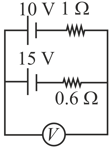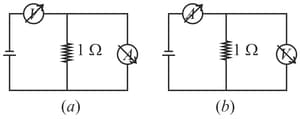Why is voltmeter always connected in parallel circuits?
Important Questions on Moving Charges and Magnetism

Distinguish between ammeter and voltmeter.

A galvanometer of resistance giving full scale deflection for a current of milliampere is to be changed into a voltmeter of range .
A resistance of _____ has to be connected in series with the galvanometer.
Derive the expression for the torque acting on the rectangular current carrying coil of a galvanometer. Why is the magnetic field made radial?
A student uses the resistance of a known resistor ( ) to calibrate a voltmeter and an ammeter using the circuits shown below. The student measures the ratio of the voltage to current to be in circuit
(a) and in circuit (b). From these measurements, the resistance (in ) of the voltmeter and ammeter are found to be close to

How do you convert a moving coil galvanometer into an ammeter?

